|
|
|
Sort Order |
|
|
|
Items / Page
|
|
|
|
|
|
|
| Srl | Item |
| 1 |
ID:
190089


|
|
|
|
|
| Summary/Abstract |
This is an interdisciplinary study that explores the impact of listening to the Qur'an on the physiological and psychological statuses of an average Egyptian Muslim. It is a transcendental phenomenological study that intersects with theories and concepts from different disciplines including reception studies, media, and popular culture analysis. The study uses two tools that are common in transcendental phenomenological studies: journals, memoirs, and in-depth interviews. Such tools help investigating the experience of listening to the Qur’an as an ongoing stream of consciousness. The study aims at exploring the phenomenon of listening to the Qur’an from the points of view of six participants who are heavy listeners of the Qur’an and are in the habit of writing memoirs and diaries, as a multi-case study purposive sample. The study reveals that the ritual practice of listening to the Qur'an differs from one person to another depending on several factors mainly gender and educational background. Analysis of the replies of the study respondents sheds light on the positive influence of listening to the Qur’an, and the characteristics of a good reciter from Muslims’ point of view. Future studies on a bigger sample are highly recommended so as to gain deeper insights into the influence of this Islamic ritual, leading to possible generalization.
|
|
|
|
|
|
|
|
|
|
|
|
|
|
|
|
| 2 |
ID:
190090
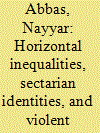

|
|
|
|
|
| Summary/Abstract |
Sectarian-based violent extremism has long been a security concern for the Government of Pakistan. Despite the perseverance of state authorities in countering violent extremism, a discourse centered on horizontal inequalities as the determinant of violent extremism and conflict remains lacking. This paper highlights the importance of an empirical study in understanding the nexus between horizontal inequalities and sectarian-based violent extremism in Gilgit-Baltistan (GB). By analyzing the responses from Shia and Sunni sectarian identities, the study contextualizes violent conflict and elucidates how horizontal inequalities intersect with sectarian identities in the capital city of GB. In doing so, socioeconomic and cultural inequalities have been evaluated. The study relies on a multistage random sample of 212 respondents through a structured questionnaire. The findings reflect significant socioeconomic inequalities between the sectarian identities and suggest a linear relationship in which horizontal inequalities generate identity-driven “us” vs “them.”
|
|
|
|
|
|
|
|
|
|
|
|
|
|
|
|
| 3 |
ID:
190091
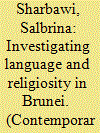

|
|
|
|
|
| Summary/Abstract |
The inexplicable link between the Malay language and Islam has been well-documented in Malaysia. In Brunei, however, this association has not been made explicit and could only be inferred through the state’s stance of utilising only the Malay language for Islamic-related matters, most conspicuously in the Islamic education curriculum. While this practice has been in place since the early days of Islamic education in the country, the changing linguistic situation in Brunei, where English is now more popular than Malay among the younger generation, may require some rethinking of this practice. An earlier study investigating the issues of language and religion in Brunei has found that those who are more English-inclined do not identify strongly with the Muslim identity as their Malay-leaning counterparts. Taking its cue from those findings, the present study extends the investigation in two ways: one, by adding the social variables age, gender and educational background in its analysis; and two, by focusing on the notion of religiosity rather than on religious identity alone. The findings show that age and language proclivity are both predictors of religiosity with older Bruneians displaying greater religiosity than the younger ones. Language also plays a factor such that those who are predisposed to using more English than Malay have fewer manifestations of practices aligned to the Islamic teaching. Gender and educational level, however, have low factor loadings and are not contributory to the measurement of religiosity.
|
|
|
|
|
|
|
|
|
|
|
|
|
|
|
|
| 4 |
ID:
190086
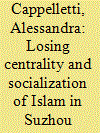

|
|
|
|
|
| Summary/Abstract |
Cultural and political alterity in China is levelled by disrupting local communities and networks, both necessary to keep memories and sense of identity alive through sharing and socialising. By taking Suzhou’s mosques as focal lens, the author assesses an experiential void which is politically and socially created, and shows the consequences of rewriting history. The broken nexus between buildings, communities and memories impacts the historical centrality and socialization of Islam in Suzhou, where communities are dispersed and shared memories are lost. Mosques’ positionality in the urban fabric is assessed through interviews and interaction with local Muslims, and the identification of past surrounding communities and networks. The assessment of the heterotopic dimension and contested memories of Suzhou’s mosques in a contemporary context — performed by collecting historical, intellectual, topographical and architectural fragments — allows us to grasp the highly symbolic dimensions of a past diversity in identity spaces. The role of communities in relation with the city’s rich intellectual past — including its tradition of literati translating Islamic classics from Persian to Chinese — is understood as central, together with a spiritual geography made of connections and relations among places.
|
|
|
|
|
|
|
|
|
|
|
|
|
|
|
|
| 5 |
ID:
190085
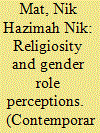

|
|
|
|
|
| Summary/Abstract |
This study explores how religiosity has shaped gender role perceptions in modern Malaysia. As part of a major research on gender equality in Malaysia, this paper discusses findings from male respondents on their gender role perceptions in regard to their experience as working fathers. This research employed a case study approach and interviews with working fathers on the perceptions of their role and their wife’s role as working mothers. Using Leximancer text processing, the interview data were analysed and formed a basis for data structure development based on Gioia’s data analysis framework. Religiosity is regarded as a main influencer shaping men’s perceptions of gender role. However, religiosity is often overrated when justifying the inappropriateness of gender attitudes. Culture embedded in individual values forms a strong foundation in society to shape the stratification system on their own. This study’s findings highlight misconceptions about Islamic teachings as a hindrance to gender equality. Instead, Islamic teachings clearly noted the equality of every human being regardless of gender differences. The study’s implication is discussed in relation to the negative impact of stigma by association, which develops a long-lasting effect towards Islam inculcating movement towards gender equality. Islam is applicable and relevant across time, although society is changing into the modern era if the transmission of the sharia (Islamic jurisdiction) is done appropriately to form a strong understanding of correct practices.
|
|
|
|
|
|
|
|
|
|
|
|
|
|
|
|
| 6 |
ID:
190087


|
|
|
|
|
| Summary/Abstract |
In Shiite culture, pilgrimage and shrines of Imams and Imams are very important. Shrines in Islamic Iranian cities have a special place in terms of belief, culture, pilgrimage, tourism, and urban. Some of these shrines, such as the shrines of Mashhad and Qom, have pilgrims from different cities and countries. Pilgrimage tourism in Shiite cities has various dimensions and needs that lack of attention to them creates various problems. Therefore, the purpose of this article is to explain the dimensions and strategies for the development of pilgrimage tourism in the pilgrimage cities of Iran, which has been done by researching the content of the text with a qualitative and interdisciplinary approach. The results indicate that shrines have different typologies such as the tombs of imams, religious leaders, and shrines. Pilgrimage tourism in the pilgrimage cities of Iran has physical, functional, access and movement spatial components, urban, social, cultural, and environmental landscape, which requires comprehensive planning and design and a special perspective for the development of the shrine in all dimensions. It is also necessary to pay attention to local conditions and cultural and social contexts, rituals and traditions of pilgrimage, the needs of pilgrims, functional infrastructure, tourism, and services.
|
|
|
|
|
|
|
|
|
|
|
|
|
|
|
|
| 7 |
ID:
190088
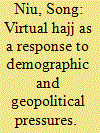

|
|
|
|
|
| Summary/Abstract |
Hajj is the most important one of the Five Pillars in Islam. Islam makes the Kaaba as the orientation of daily prayers (salat), and hajj as the linkage to maintain the global Muslim faith community. The sanctity of hajj rituals is of positive significance for global pilgrims to transcend the boundaries of countries and ethnic groups. In the era of globalization, hajj quota has long been a scarce resource. It is difficult for most Muslims to obtain hajj permits from Saudi Arabia in a short term. Even non-Muslims are full of concern about Islam, especially the hajj. Then, the “virtual hajj,” which is similar to the real hajj in the sacred city Mecca, came into being. It is mainly divided into several types: (1) building the real scenes of Kaaba and other hajj sites, and Muslims participating in the “virtual hajj” through role-playing; (2) the “virtual hajj” apps developed through 3D digital technology and their upgraded versions; (3) the “virtual hajj” live broadcasting the real hajj to non-pilgrims through the pilgrim’s smartphone with the 5G network technology; and (4) the “virtual hajj” software developed by VR and AR technology in the Metaverse era. The main functions of “virtual hajj” are embodied in four aspects: protest against Saudi Arabia, Islamic education, universal effect, and the COVID-19 fighting. All types of “virtual hajj” have positive effects on both the Muslims and non-Muslims. However, there are different voices from religious circles on how to treat “virtual hajj.”
|
|
|
|
|
|
|
|
|
|
|
|
|
|
|
|
|
|
|
|
|